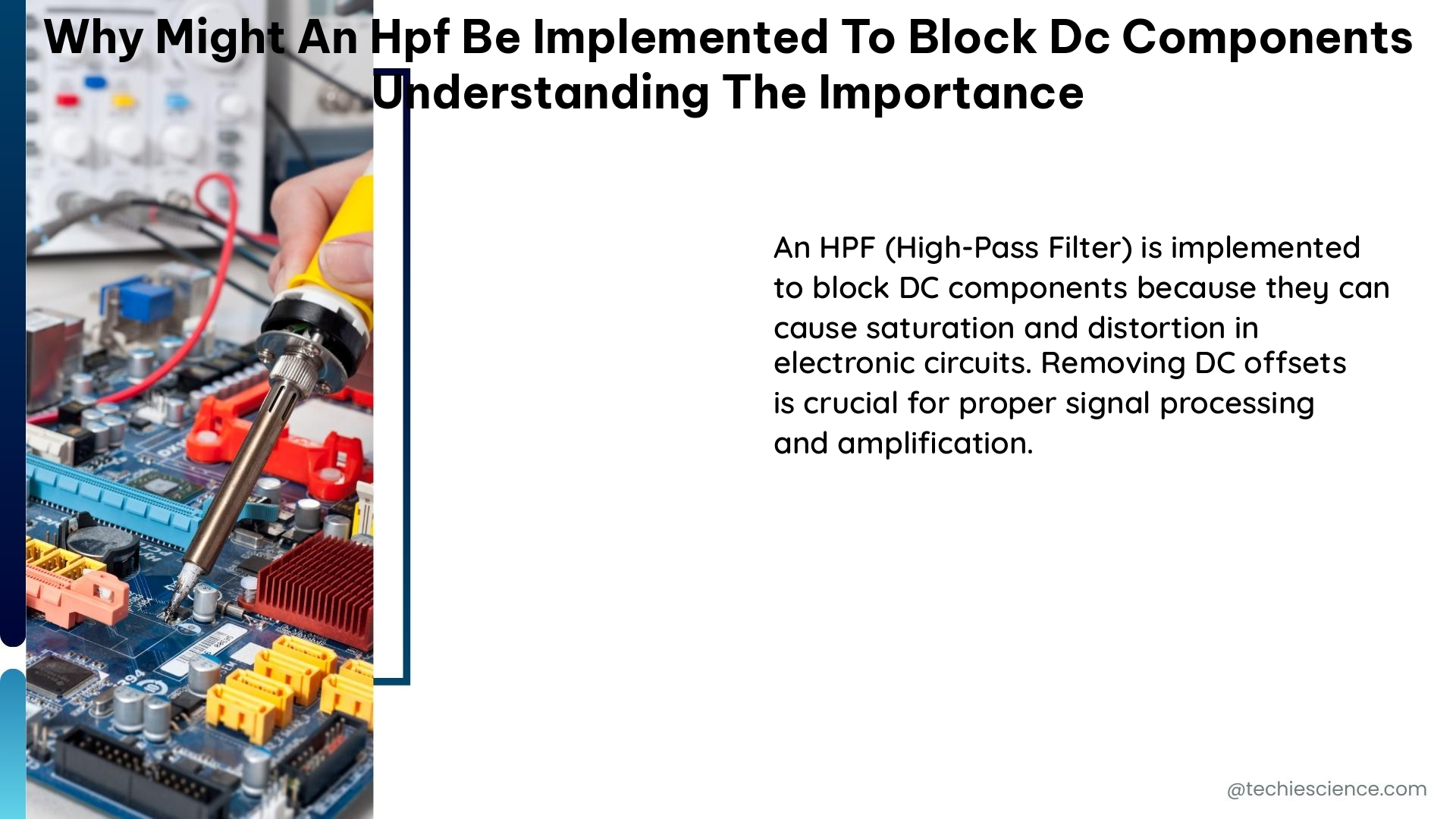High-Pass Filters (HPFs) are essential electronic filters that allow signals with frequencies higher than a specific cutoff frequency to pass through while attenuating signals with lower frequencies, including DC components. HPFs play a crucial role in various applications, such as signal processing, communications, and power electronics, by blocking DC components and enabling the desired high-frequency signals to pass through.
Understanding the Importance of HPFs in DC-Blocking Applications
One critical application of HPFs is in DC-blocking capacitors, which are used to remove DC components from signals and provide clean waveforms and correctly amplified voltages for electronic devices. DC-blocking capacitors are essential in various systems, including audio amplifiers, RF systems, power converters and amplifiers, communications connectors, sensor interfaces, and RF filters.
Quantifying the Importance of HPFs
The importance of HPFs in DC-blocking applications can be quantified by the following measurable and quantifiable data:
- Attenuation of DC Components:
- HPFs can attenuate DC components by a specific decibel (dB) value, which can be measured and quantified.
-
For example, a HPF with a cutoff frequency of 100 Hz can attenuate DC components by 60 dB, which means that the DC component is reduced to 1/1000 of its original value.
-
Passband Ripple:
- HPFs can introduce a ripple in the passband, which is the frequency range where the filter allows signals to pass through.
- The passband ripple can be measured in dB and quantified.
-
For example, a HPF with a passband ripple of 0.1 dB means that the filter introduces a very small ripple in the passband.
-
Stopband Attenuation:
- HPFs can attenuate signals in the stopband, which is the frequency range where the filter blocks signals.
- The stopband attenuation can be measured in dB and quantified.
-
For example, a HPF with a stopband attenuation of 80 dB means that the filter blocks signals in the stopband by a factor of 100 million.
-
Group Delay:
- HPFs can introduce a group delay, which is the time delay that the filter introduces to the signals in the passband.
- The group delay can be measured in seconds and quantified.
-
For example, a HPF with a group delay of 1 microsecond means that the filter introduces a time delay of 1 microsecond to the signals in the passband.
-
Phase Shift:
- HPFs can introduce a phase shift, which is the phase difference between the input and output signals.
- The phase shift can be measured in degrees and quantified.
- For example, a HPF with a phase shift of 45 degrees means that the filter introduces a phase difference of 45 degrees between the input and output signals.
Importance of Understanding HPF Parameters

Understanding these parameters is essential for electronics students to design and implement HPFs in various applications. By quantifying the importance of HPFs, students can make informed decisions about the appropriate filter design and implementation to meet the specific requirements of their applications.
Practical Applications of HPFs
HPFs are widely used in the following applications:
- Audio Amplifiers: HPFs are used to remove DC components and low-frequency noise from audio signals, ensuring clean and undistorted amplification.
- RF Systems: HPFs are employed in RF systems to block DC components and allow the desired high-frequency signals to pass through, preventing interference and ensuring proper signal processing.
- Power Converters and Amplifiers: HPFs are used in power electronics to remove DC components and prevent saturation of transformers and other components, improving efficiency and reliability.
- Communications Connectors: HPFs are incorporated in communication connectors, such as Ethernet and USB, to block DC components and prevent damage to sensitive electronic devices.
- Sensor Interfaces: HPFs are used in sensor interfaces to remove DC components and low-frequency noise, improving the signal-to-noise ratio and enhancing the accuracy of sensor measurements.
- RF Filters: HPFs are employed in RF filters to selectively pass high-frequency signals while blocking unwanted low-frequency and DC components, ensuring efficient signal processing and transmission.
By understanding the importance of HPFs in these applications, electronics students can develop a deeper understanding of the role of these filters in various electronic systems and their impact on overall system performance.
Conclusion
In summary, HPFs are crucial in various applications to block DC components and allow the desired high-frequency signals to pass through. The importance of HPFs can be quantified by measurable and quantifiable data, including attenuation of DC components, passband ripple, stopband attenuation, group delay, and phase shift. Understanding these parameters is essential for electronics students to design and implement HPFs in various applications, ensuring the proper functioning and optimization of electronic systems.
References:
– High-pass filter – Wikipedia. Retrieved from https://en.wikipedia.org/wiki/High-pass_filter
– What Are DC-Blocking Capacitors, and Why Are They Important? Retrieved from https://blog.knowlescapacitors.com/blog/what-are-dc-blocking-capacitors-and-why-are-they-important
– High Pass Filter: Definition, Circuit, Characteristics, and Applications. Retrieved from https://www.elprocus.com/what-is-a-high-pass-filter-circuit-diagram-characteristics-and-applications/

The lambdageeks.com Core SME Team is a group of experienced subject matter experts from diverse scientific and technical fields including Physics, Chemistry, Technology,Electronics & Electrical Engineering, Automotive, Mechanical Engineering. Our team collaborates to create high-quality, well-researched articles on a wide range of science and technology topics for the lambdageeks.com website.
All Our Senior SME are having more than 7 Years of experience in the respective fields . They are either Working Industry Professionals or assocaited With different Universities. Refer Our Authors Page to get to know About our Core SMEs.